
I feel that I am perhaps the last individual in the Disney blogosphere to post any sort of public comment about the recent controversy surrounding the rumored changes to Disneyland’s version of it’s a small world. This is due to a number of reasons, but mostly, as a grizzled veteran of Eisner’s last decade at the helm of the Walt Disney company, I have attained a degree of scandal fatigue. Quite simply, I have seen so many desecrations and obscenities foisted upon the art of themed entertainment and design that I have become inured to such grand disappointments.
I fought in the Toad Wars of 1998, had the first website devoted to saving Horizons and wrote a letter so incensed by Journey Into YOUR Imagination that I got a call at home from the then Vice President of EPCOT Center. I watched Disney built a park with amazing theming but little to do (Animal Kingdom), minimal theming and nothing to do (California Adventure) and no theming and nothing to do (Disney Studios Paris). I consider Hong Kong Disneyland something of a gated botanical gardens. After wands and hats and Pop Century, I had no store of indignation left.
 Young revolutionaries on the barricades – the last Toad-In, September 7, 1998.
Young revolutionaries on the barricades – the last Toad-In, September 7, 1998.I seem distracted.
But just as things looked bleakest, there was a ray of hope. Paul Pressler left to destroy another company. Michael Eisner left to hang out with Bette Midler and trade baseball cards. John Lasseter and the Pixar squad rode in on their white horses to give the triage badly needed by a dying WDI and dead Feature Animation department. Even Bob Iger, Eisner’s hand-picked successor, proved me wrong and wound up not being a proxy for the departed CEO but a fairly bold new leader who embraced a far more progressive view of new technologies than his predecessor. Surely, everyone would live happily ever after.
Still, all was not well. The management purges and noxious politics of the last decade had left Imagineering paranoid and factionalized, split between the embattled creatives who had managed to survive in the hope of better days ahead and those who, bolstered by political maneuvering and their ability to “play the game” successfully had risen through the ranks. Not since the Augean stables had an organization so desperately needed a flushing out of the dross and a complete rebuilding.
While change came, however, it came slowly. Sub-par attractions still filtered out into the parks, and more alarmingly, newly announced attractions started to have a noticeably Pixar-centric tilt. The “toonification” of the parks amped up in earnest, and areas that once whisked guests away to adventure in fantastic but real-world settings became new venues for promoting the Franchise of the Month. It seemed that at our moment of greatest triumph, the folks from marketing had won after all. The parks were going to become ads for character merchandise, and the days of the great non-“property” rides like Pirates or Mansion might never return.
 Oh noes.
Oh noes.There remained reasons for optimism, though, and obviously a great deal of wonderful, devoted and creative staff continue to try their best to keep the company living up to Walt’s ideals. I’ve tended to cut them slack even in times of irritation, and even though I might disagree with their choices I’m usually eager to see where they’re going in the hopes that the ship will eventually get turned around completely. So, for a while, my crusading came to an end.
Recently, though, rumors emerged of something so strangely unnecessary, blinkered and contrary to both good taste and Disney legacy that I felt that old activist drumbeat once more. Something had been planned so purely based in concepts of “marketing” and “brand awareness” and intended to move merchandise that it can’t help but to raise the hackles of fans. Something that strikes right at the nexus of several “sacrosanct” movements in Disney park history, and something that was neither asked for or needed.
So why not? Once more into the breach, dear friends. Start your petitions and phone calls, emails and letters. Grab the pitchforks and light up those torches, because they’re going to screw around with it’s a small world.
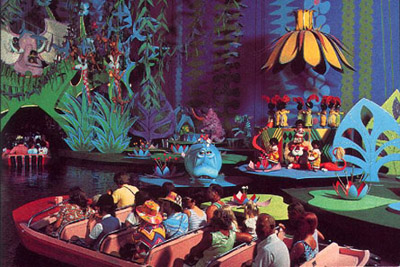
First a disclaimer, lest anyone who actually knows me posts accusations of rank hypocrisy. I have never personally been an enormous fan of it’s a small world, and was not among the ranks of children “enchanted” and “delighted” by it. Then again, I was far more cynical in general as a child than I am now so that’s no surprise. At the time my enthusiasm for the ride extended mostly to it being a boat ride – always a plus – and the ever crucial Disney Water Smell ™. In fact, my appreciation for the attraction did not begin in earnest until my teenage years, when I began to realize how singularly strange it is. Its overt, mid-century pop-art aesthetic grounds it in a design tradition long gone from any other Disney attraction. Surreal and vaguely bizarre details are peppered throughout the ride, and it was this embracing of its funky hipster aesthetic that eventually spurred my appreciation. Aside from my feelings, though, many thousands of people over the years have loved this attraction. This begs the question, why is it’s a small world important?
 Mary Blair’s concept art for the attraction
Mary Blair’s concept art for the attractionHistorically, it’s a small world falls into a number of important and distinguished categories. It was overseen by Walt himself. It was one of the four famous attractions built for the 1964/65 World’s Fair, which allowed Disney to make great leaps in attraction design and scope out the possibilities of an east coast Disneyland. It was also the single most prominent example of an attraction that reflected the unique styles of its Imagineering design team.
 Walt Disney is perhaps the greatest “producer” in entertainment history. The products to which he affixed his name reflected not his own artistic skills, but rather the sum total of the hundreds of artists and craftsmen in his employ. All fans know the anecdote about Walt telling the child that he no longer drew, or wrote gags, but rather went around the studio spreading ideas like a bee pollinating flowers. That was Walt’s great gift – to sniff out talent, bring artists together in the way that best enhanced their abilities, and to pick from their output the absolute best ideas and bring them to fruition. There was little room for the auteur or big-name artist in Walt’s system. Everyone collaborated in anonymity to produce the best synthesis of ideas possible. There were few exceptions – one of which was it’s a small world.
Walt Disney is perhaps the greatest “producer” in entertainment history. The products to which he affixed his name reflected not his own artistic skills, but rather the sum total of the hundreds of artists and craftsmen in his employ. All fans know the anecdote about Walt telling the child that he no longer drew, or wrote gags, but rather went around the studio spreading ideas like a bee pollinating flowers. That was Walt’s great gift – to sniff out talent, bring artists together in the way that best enhanced their abilities, and to pick from their output the absolute best ideas and bring them to fruition. There was little room for the auteur or big-name artist in Walt’s system. Everyone collaborated in anonymity to produce the best synthesis of ideas possible. There were few exceptions – one of which was it’s a small world.
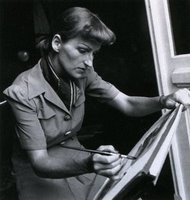 Disney was an enormous fan of artist Mary Blair, who had long worked as an illustrator and conceptual designer in his animation studio. Yet Walt was always frustrated with the inability of the animators to bring her unique style to the screen. He brought her eventually to Imagineering, hoping to use her talents in park design. Blair would be the most prominent design influence on it’s a small world, but several other well-known Imagineers also had important hands in its creation, key amongst them Rolly Crump, Alice and Marc Davis, Blaine Gibson, Harriet Burns and Joyce Carlson.
Disney was an enormous fan of artist Mary Blair, who had long worked as an illustrator and conceptual designer in his animation studio. Yet Walt was always frustrated with the inability of the animators to bring her unique style to the screen. He brought her eventually to Imagineering, hoping to use her talents in park design. Blair would be the most prominent design influence on it’s a small world, but several other well-known Imagineers also had important hands in its creation, key amongst them Rolly Crump, Alice and Marc Davis, Blaine Gibson, Harriet Burns and Joyce Carlson.
it’s a small world is also unique among most Disney attractions in that it was specifically created to convey a message. Built for the World’s Fair, sponsored by Pepsi with all proceeds going to UNICEF, the ride was intended as a plea for world peace. By depicting various cultures in the form of child-like dolls all linked by that familiar, looping song, Imagineers intended to underline both the things that make us unique and the ties that bind us all. It was a tribute to the children of the world, filtered through a uniquely 1960’s sense of optimism.
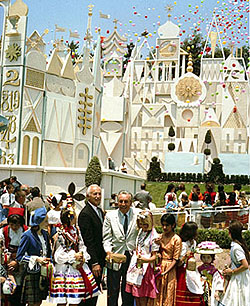 Opening day at Disneyland
Opening day at DisneylandThe ride moved to Disneyland in 1966 when the Fair closed and appeared on opening day at the later Magic Kingdoms in Florida, Tokyo and Paris. Despite long periods of neglect typical of the later Eisner years, Disneyland’s version of the attraction remains popular to this day. Florida’s small world recently received a much-needed facelift and also continues to constantly draw a queue, even forty years after the ride was first created. The attraction and its theme song, penned by the Sherman Brothers, are known worldwide – even if it’s being mocked or parodied, people who have never even been to a Disney park know about it’s a small world.
When Hong Kong Disneyland opened inauspiciously in 2005, most coverage of the park was quick to note its relative lack of attractions. With only two traditional dark rides, Hong Kong Disneyland lacked most of the most famous Disney attractions, including it’s a small world. The ride was rumored to be amongst the park’s first plans for expansion, though, and in late 2006 it was announced that Hong Kong’s it’s a small world would open in 2008.
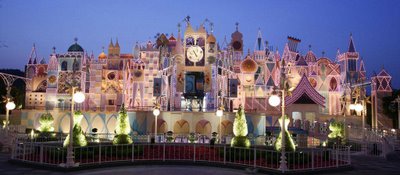 Disney-released image of Hong Kong Disneyland’s it’s a small world, which opens April 28th.
Disney-released image of Hong Kong Disneyland’s it’s a small world, which opens April 28th.As the ride made its way towards its April, 2008, opening day, Disney revealed that this iteration of the classic attraction would feature something new – the addition of Disney animated characters to the show scenes. Disney justified this by claiming that Chinese visitors were not as familiar with classic Disney films as western guests, and thus the ride would serve as an introduction to the world of Disney and a primer on its best-known characters. Pictures began to trickle out of the new ride, and ranged from pretty good to O.K. to pretty terrible. Just as disturbing was the news that the score of the attraction – known to pretty much every kid worldwide – would be changed to incorporate themes from the films being depicted.
 Why?
Why?Personally, I was unfazed by all this as it was a new installation of the attraction and wouldn’t replace the ‘classic’ version that Walt built. It would also be easy to ignore as I wouldn’t be going to Hong Kong anytime soon anyway – at least not until they build something to do there.
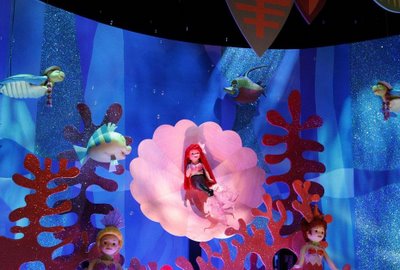 A salute to our mermaid underlords and the half-fish children of the world. Not pictured: Prince Namor, the Sub-Mariner
A salute to our mermaid underlords and the half-fish children of the world. Not pictured: Prince Namor, the Sub-MarinerFanboy detachment would end, though, when this insidious concept struck at the homeland. First reported by Al Lutz and confirmed by the watchdogs at Re-Imagineering and then the L.A. Times, rumors emerged that WDI would take the opportunity during Disneyland’s upcoming and much needed rehab to its own it’s a small world to add character dolls. Even more confounding was the news that the rainforest scene – one of the highlights of the attraction – would be bulldozed to add a “salute to America” scene. The hilarious irony of this was not lost on fans, who instantly began a campaign to “Save the Rainforest” while Disney was still hedging on whether to confirm the rumors.
The reasons these changes upset fans so greatly are varied and complex. The importance of this attraction historically has already been underlined in this article, as has its continuing popularity. Its ridership numbers bear up the fact that it’s doing just fine without being made “hip”, “edgy”, or “relevant”. The changes therefore seem arbitrary and unnecessary.
Add to these concerns the fact that American visitors do not need to be introduced to the characters. Characters are everywhere in the parks, and pervade our media. The “stars” of it’s a small world were intended to be the children of the world, not the fictional characters of animated films. Turning the ride into a “Where’s Waldo” of sorts completely serves to miss the point of the attraction. And who are these characters supposed to represent? Sure, Alice (of Wonderland fame) is English, but who does Ariel represent? Our mysterious mer-folk neighbors? And where in the representations of children do princesses, toy cowboys, and destructive alien fugitives fit?
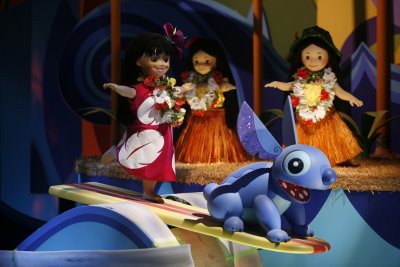 Spot the intergalactic criminal, kids!
Spot the intergalactic criminal, kids!These changes also seem to perfectly tap the concerns of many fans mentioned earlier; namely, that the Disney parks are slowly becoming mere merchandising opportunities for characters and licensed properties. One by one, attractions that were formerly “stand-alone” have been re-built to include animated characters in their storylines. The Tomorrowlands, once focused on a very reality-based futuristic vision for mankind, are now inhabited by Buzz Lightyear, Nemo, Stitch, Star Wars, shrinking children, and – inexplicably – fantasy monsters. Adventurelands have been invaded by Aladdin, African birds, the Lion King, Stitch (again!) in Tokyo, Tarzan and – less egregiously – Jack Sparrow. Not content with just Adventureland, Jack also took over Disneyland’s Frontierland. The “realistic” wonders of EPCOT now include Nemo (again) and the Three Caballeros. Aside from Florida’s Expedition Everest, it almost seems unthinkable that we’ll ever see another attraction that isn’t based on a pre-existing property. For parks that were originally intended to whisk guests away to adventure in reality-based environments, that’s a major philosophical change.
Concerns of character aside, there’s also the semiotically insane plan to bulldoze the rainforest to add a tribute to America. Aside from the cheap and easy P.R. attacks that it allows, it goes against one of the core design decisions during the ride’s creation – that the U.S.A. would not be included in the ride. The Imagineers behind the attraction intended that, for once, Americans would take a step back and look at the world around them, and acting as hosts tastefully declined to include any flag-waving at the end. It’s not as if Walt forgot to include America – he intentionally chose to leave it out.
 The strangely disconcerting U.S.A. show scene in the Disneyland Paris version of the attraction
The strangely disconcerting U.S.A. show scene in the Disneyland Paris version of the attractionPerhaps that’s the most egregious part of this process – it’s a small world was designed while Disney was at the top of his game, and when he had plenty of resources at his disposal to make his dreams reality. Unlike his animation studios, which were always pressed for cash until at least the 1950s, or Disneyland in 1955 which cost every cent Walt could possibly muster, Imagineering in 1964 could do pretty much whatever they wanted with it’s a small world that technology would allow. The end product of that creative process is in the park. It’s not that Walt wanted to include characters or fancier animatronics but couldn’t afford it, or ran out of time and space to include America. The ride as it is is probably pretty much exactly how Walt wanted it to be. So seeing as any overused homily about how Walt was always changing the parks would be fairly out of context here, care to guess what Disney’s first line of defense against fan criticism was?
As Re-Imagineering intensified their campaign and fan outcry grew, the press became interested. Various media began to cover the story and reaction against the changes began to grow; even highly improbable outlets such as TMZ chimed in. Predictably, Disney send their first line of defense – a press agent – to respond to the charges via the Los Angeles Times:
Walt Disney Imagineering spokeswoman Marilyn Waters said a number of familiar characters would appear in “stylized” form in the overhauled ride and placed into appropriate countries. Mickey and Minnie Mouse are not part of the plan, she said.
The changes carry on Disney’s tradition of “plussing” attractions, Waters said, and help enrich the storytelling and keep the experience relevant for future generations.
“No one approaches our classic attractions with more reverence than Disney Imagineers, who take great care when refreshing beloved attractions,” Waters said, adding that the original intent and celebration of children will be “retained and strengthened.”
Many of these buzzwords will be familiar to fans who have witnessed previous park changes. What makes many nervous is how many of those changed attractions wound up being “enriched” and made “relevant”. Also familiar is the pattern of vague denial the company exhibited in many statements, unwilling to admit to changes that were already underway. The outcry continued, with Re-Imagineering publishing a letter to Disney from Mary Blair’s family and also compiling a list of quotes from prominent animators opposed to the change. From the Blair family’s letter:
The Disney characters of themselves are positive company icons, but they do NOT fit in with the original theme of the ride. They will do nothing except to marginalize the rightful stars of the ride “The Children of the World”. This marginalization will do nothing but infuriate the ride’s international guests and devoted Disney fans.
My Mother and I have always had a strong sense of patriotism for America and I DO support a tribute to America. Disneyland has several venues, which are perfect places for this tribute including “Main Street USA” or “New Orleans Square”; unfortunately the “It’s a Small World” ride is NOT one of them. Once again this will marginalize the children of the world theme and bastardize my Mother’s original art. Furthermore ripping out a rainforest (Imaginary or otherwise) and replacing it with misplaced patriotism is a public relations blunder so big you could run a Monorail through it.
As a former WED employee I am saddened to realize the degradation of the company’s talent and focus and the subsequent decline at the Disneyland Park itself. I cannot believe someone from WDI was paid to come up with such an idiotic plan as this.
As the head of the Blair family I cannot urge you strongly enough to abandon this idiotic plan and instead upgrade the boats and return the ride to it’s original classic form, design and colors. The desecration of Mary’s art is an insult to Mary Blair, her art, and her memory, and to the entire Blair Family itself.
Among the many wonderful comments from animators, this was my favorite:
“I’m totally pissed about (the Disney character additions to) ‘Small World’, but maybe I’ve grown to accept the gradual crapification of anything good about Disneyland by people who care only about cross linking everything they own so that they each advertise each other. This is just one more step closer to a Disneyland boiled down to a series of billboard advertisements with a merchandise shop as the wiener at the end.”
Don Shank
Visual Development Artist / The Incredibles
As criticism intensified, Disney tried an odd and unexpected tactic – they issued a letter from Disney historian and head archivist Dave Smith. Smith, well known and loved by fans, is indeed a Disney legend but as he’s not an Imagineer it’s odd that Disney would have sent him to take flak for them. From his letter:
With regard to the current controversy about changes being made in It’s a Small World at Disneyland, allow me, as the Chief Archivist at the Disney company for the past 38 years, to remind those who are complaining that Walt Disney never intended Disneyland to be static. To a reporter when Disneyland opened he said, “Disneyland will never be completed; it will continue to grow as long as there is imagination left in the world.”
…
Walt Disney was constantly changing his park, just as he said he would. And those changes did not end with Walt’s death over 40 years ago. The Disney Imagineers have continued to follow his dream, frequently adding and changing things in the park to give today’s guests the best possible experience. The public expects more from Disney than they do from most companies, and we try to live up to that trust by continually improving a guest’s visit to our park. And, sure enough, those trees have kept growing and getting more beautiful every year.
 Now while I’m going to seem critical of Smith here, I feel the need to point out that I have nothing but respect for the work he’s done over the past four decades for the preservation of Disney history. I’ve never heard anything but nice things about him, and my single brief meeting with him – at EPCOT for its 25th anniversary – does nothing to dissuade me from believing that he’s a very nice guy who really cares about Disney and the fans. Nevertheless, his letter contained nothing to assuage any fan concerns and could have been any given form letter spat out over the last fifteen years from the “Walt-O-Matic 3000” that Disney P.R. used to deflect any criticism whatever with a handful of out-of-context quotes from old Disney interviews.
Now while I’m going to seem critical of Smith here, I feel the need to point out that I have nothing but respect for the work he’s done over the past four decades for the preservation of Disney history. I’ve never heard anything but nice things about him, and my single brief meeting with him – at EPCOT for its 25th anniversary – does nothing to dissuade me from believing that he’s a very nice guy who really cares about Disney and the fans. Nevertheless, his letter contained nothing to assuage any fan concerns and could have been any given form letter spat out over the last fifteen years from the “Walt-O-Matic 3000” that Disney P.R. used to deflect any criticism whatever with a handful of out-of-context quotes from old Disney interviews.
It’s obvious that Walt was always pushing for change in Disneyland. That’s because as the park was built in 1955 there was not only a great deal of empty space but a great many sub-par or completely inadequate attractions. Disneyland was built in about a year for $17 Million and, as stated previously, Walt couldn’t get another cent of financing for its completion. Only through the park’s success was he able to start realizing his real vision, which is why there were massive overhauls throughout the 1950s with major upgrades in 1959 and 1967. Walt expanded and built new things, while tearing out placeholder attractions and exhibits as needed or as technology allowed. It’s doubtful that the current changes to it’s a small world fit that pattern.
Unsatisfied by Smith’s response, Laughingplace.com sent a followup question pointing out that many people aren’t opposed to change in general but simply this change, and that many feel the focus on characters will eliminate the purpose of the original attraction. Smith’s response:
It is difficult for me to speak to that, since I do not know what characters are being put in the attraction, or what they will look like. But, we have added characters to previous character-free attractions: witness Pirates of the Caribbean (Jack Sparrow), Tiki Room (Iago, at the Magic Kingdom in FL), Treehouse (Tarzan), Big Thunder Ranch (Little Patch of Heaven), Tom Sawyer Island (Pirates Lair), Main Street Cinema (Disney cartoons), Haunted Mansion (Haunted Mansion Holiday), Submarine Voyage (Finding Nemo Submarine Voyage), El Rio del Tiempo (Gran Fiesta Tour, at Epcot), The Living Seas (starring Nemo and Friends, Epcot). Because of the great number of Audio-Animatronics children in Small World, I cannot imagine that the addition of a few characters like Alice in Wonderland will affect the theme.
This sent up real red flags, as not only was Smith unsure about what changes will be made, but he cited a list of previous attractions which had been “up-charactered”. Not only does this simply underline what is a massive concern for many fans to begin with, but it includes several inauspicious entries including one of the first and most hated changes, the rehab of Florida’s Enchanted Tiki Room – Under New Management!. This change has only proven more and more unpopular over the years, and if anything hurt the ridership numbers they were trying to increase.
 BECAUSE YELLING IS FUNNY!!!!!!
BECAUSE YELLING IS FUNNY!!!!!!Seeing as Smith’s letter didn’t do the trick, Disney P.R. pulled out the big guns and sent out a letter from Marty Sklar, Imagineering Ambassador and one of the few remaining folks at WDI to have worked alongside Walt himself. From Marty’s letter:
We all agree that “It’s A Small World” is a Disney classic. But the greatest “change agent” who ever walked down Main Street at Disneyland was Walt himself. In fact, the park had not been open 24 hours when Walt began to “plus” Disneyland, and he never stopped. Having started my Disney career at Disneyland one month before the park opened in 1955, I can cite countless examples.
…
Now the rumors are swirling that we are “ruining Walt’s creation.” I’ve heard that we are planning to remove the rainforest, add Mickey and Minnie Mouse, create an “Up with America” tribute, to effectively “marginalize” the Mary Blair style and Walt’s classic (all not true).
In fact, just the opposite is true. We want the message of brotherhood and good will among all children around the world to resonate with more people than ever before, especially today’s young people. Our objective is to have everyone who experiences “It’s a Small World” understand (in the words the Shermans’ wrote 44 years ago) that “there is just one moon, and one golden sun, and a smile means friendship to everyone.”
To make “It’s A Small World” even more relevant to our guests, Tony Baxter (who created the concepts for Big Thunder Mountain Railroad, Splash Mountain and other Disneyland classics) and I arrived at the same place eight years ago. To accomplish our objective, we decided to seamlessly integrate Disney characters into appropriate thematic scenes in the attraction, and do it completely in the distinctive “Mary Blair style.” We spent many long months exploring ways to accomplish this.
We are not turning this classic attraction into a marketing pitch for Disney plush toys (rumors to the contrary). Between Tony, our chief designer Kim Irvine, and me, we represent 128 years creating Disney park entertainment and fun for literally billions of guests around the world. We are not “young marketing whizzes” trying to make a name for ourselves. We were fortunate to have trained, and worked with, all of Walt’s original Imagineers.
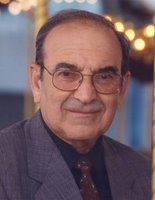 As with Dave Smith, I have a world of respect for Marty. He’s been in the trenches and seen many things, and served the company for years. Yet he only repeats the hoary and irrelevant meme of Walt as a “change agent“, and then proceeds along a very carefully constructed path of denial that only serves to deceive critics. He claims that they’re not “removing” the rainforest, yet reports from inside the ride say otherwise. Perhaps moving and marginalizing it doesn’t count as “removal”? He claims they’re not adding Mickey and Minnie – although reports never claimed that they would – but doesn’t address the addition of other characters. He also denies the creation of an “Up With America” tribute, but what does this mean? Will there not be a U.S.A. section? Reports state otherwise.
As with Dave Smith, I have a world of respect for Marty. He’s been in the trenches and seen many things, and served the company for years. Yet he only repeats the hoary and irrelevant meme of Walt as a “change agent“, and then proceeds along a very carefully constructed path of denial that only serves to deceive critics. He claims that they’re not “removing” the rainforest, yet reports from inside the ride say otherwise. Perhaps moving and marginalizing it doesn’t count as “removal”? He claims they’re not adding Mickey and Minnie – although reports never claimed that they would – but doesn’t address the addition of other characters. He also denies the creation of an “Up With America” tribute, but what does this mean? Will there not be a U.S.A. section? Reports state otherwise.
Again we come across the “relevant” buzzword. We also find out that Sklar and Baxter were looking at this eight years ago – so this was a project initiated under the old management regime. Many have wondered why this project is being pushed through as it is so unpopular outside and inside the company. Some speculate that there must be some big, hush-hush reason this plan made it through despite such widespread opposition. The story remains cloaked in mystery, although there are reports that the current changes are only post-budget cut remnants of a much more complete refurbishment plan that would have involved a more accurate rehab of the project. It’s speculated that when budgets were slashed for the much-needed maintenance, WDI looked at the characters being created for Hong Kong Disneyland and decided, to quote John Hurt in Contact, why buy one when you can have two for twice the price?
Disney continues to try and dodge the P.R. issue that has developed. On April 15, WDI sent Imagineer Kim Irvine to discuss the changes on KCRW radio. Irvine continued the pattern of avoiding the issues that critics find most troubling, while also saying that “no firm decision” had been made on the “Up with America” segment that Sklar had previously denied existed.
Essentially Disney and its fans have arrived at a stalemate. Many seem puzzled why Disney would seem to have chosen to start a flame war with its fans, and so unnecessarily. Others seem disappointed that the Disney parks are not as far out of the creative woods as it seemed when new management arrived in Burbank. The ride is currently closed and workers continue the rehab, although many hope that some degree of outcry will help stem the most egregious changes. Yet with Disney still exhibiting some of the bunker mentality that marked the darkest of the Eisner-Pressler years, it remains to be seen what will happen.
Write those letters, though. The story isn’t over yet, and while in the grand scheme of life these changes aren’t too important, for fans of Disney it’s just another sad microcosm of the loss of the company’s soul.
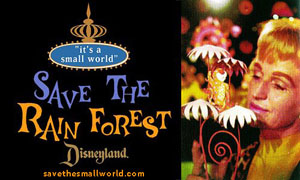









[…] Imagineering added 29 Disney characters to the Disneyland attraction in 2008 that launched a “Small World War” of protests. Anxious Disneylanders are nervously watching the Groot overlay coming to Tokyo […]